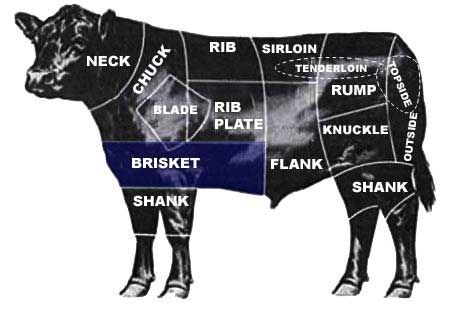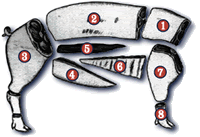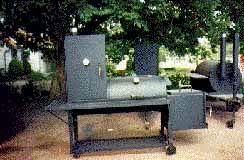Living the High Life
This originally appeared on Chef Michele's Adventures and was recently re-published on The Cook's Kitchen, but I then I realized it has never appeared here. I wrote this for Michele who's blog is primarily focused on frugal cooking. She hasn't updated her blog in a while, but hopefully she'll be back soon.
"High on the hog.” “Living the high life.” “Eating like Kings.” “Bringing home the bacon.” We’ve all heard them. There are a lot of food idioms out there that associate food with prosperity and wealth. How did this happen? Which foods were reserved for the well to do and which were reviled and given to the, shall we say, “less fortunate?”’
For every food idiom that associates food with wealth, there’s a food stuff. You know what I mean, truffles, chocolates, lobster, etc. but those are for someone else to write about. I’m only going to focus on meat and not the other food stuffs because I’m a barbecue guy and let’s face it, barbeque is about meat.
 So how does “high on the hog” and “living the high life” relate to meat? It’s actually amazingly simple. The better cuts of meat, the choice cuts, the most tender cuts, either from a cow or a pig, all come from the muscle groups of the animals that do the least amount of work. And where on the body do you think that is? Well, on both the cow and pig, it’s “high” on the animal; it’s the back, the part furthest from the ground.
So how does “high on the hog” and “living the high life” relate to meat? It’s actually amazingly simple. The better cuts of meat, the choice cuts, the most tender cuts, either from a cow or a pig, all come from the muscle groups of the animals that do the least amount of work. And where on the body do you think that is? Well, on both the cow and pig, it’s “high” on the animal; it’s the back, the part furthest from the ground.
“High” on the back of the cow where you’ll find the T-bones, the Filet Mignon, the Prime Rib, the Porterhouse and finally the less desirable sirloin. If you look at the meat around the back legs, you’ll find the rounds. On the front shoulder you find the chuck and underneath that you find the brisket; tough and stringy and worn out from its constant use. The “upper cuts”, are tender only because they don’t do much work and they cook quickly.
Back in the mists of time when traditions began, in the barbecue belt a traditional “Southern Barbecue” was actually the cooking of whole pig over an open fire. Servants or slaves would roast the animal and serve the meat as it cooked to the boss. What did the boss eat while the folks were cooking and cleaning? You guessed it - the fast cooking meat from “high” on the hog.
On a pig, those cuts are the Pork Loin, the Rack of Pork, the Tenderloin, the Pork Steaks, and Center Cut Chops. Once the best cuts were served to the master and honored guests. The sirloin, the rounds and the chuck would be served to less important people. What was left was given to the servants, the slaves or the poor White Trash.
Center Cut Chops. Once the best cuts were served to the master and honored guests. The sirloin, the rounds and the chuck would be served to less important people. What was left was given to the servants, the slaves or the poor White Trash.
But the slaves, the servants and the White Trash got the last laugh. They learned that by slow cooking the tough cuts of meat such as the spare ribs, or the pork shoulder and butt, the lowly cuts of meat were transformed into a dish “fit for a King.” There was magic in the smoke and the art of “low and slow.”
The poor, the slaves and the White Trash all learned how to control a fire so that a full beef brisket or rack of pork spare ribs would cook slowly and tenderize the meat in the process. Good barbeque literally will “melt in your mouth.” Please don’t confuse barbeque with grilling. Grilling is cooking meat quickly directly over high heat. Barbecue is low and slow with fire temperatures rarely exceeding 250 degrees.
In the barbeque belt, most cooks cooked outdoors over wood or charcoal fires. This method became barbeque. In the north, most people lived in cities or in areas where the weather required indoor cooking for many months of the year, but the rules of divvying up the meat remained. The poor, immigrants, the working class and the White Trash were all given the tough cuts of meat. In the north, braising became the method of choice in transforming tough meat to edible goodness.
So the next time you’re looking for a way to stretch your food budget, take a look at beef brisket, pork butt, spare ribs or any of the traditional barbeque foods. Last I looked, pork butt was going for $1.09 a pound and brisket was $2.19 a pound in my local supermarket while the better cuts of pork and beef were all $4.00 a pound or better. A little “low and slow” cooking either over a wood and smoke fire – barbecue, or in a pot and braised will work magic.


 The Kansas City Barbeque Society
The Kansas City Barbeque Society The New England BBQ Society
The New England BBQ Society The Mid Atlantic BBQ Association
The Mid Atlantic BBQ Association The Hampton Smoker
The Hampton Smoker Your guide to BBQ joints in Boston, New York and everywhere in between
Your guide to BBQ joints in Boston, New York and everywhere in between
 The Pickled Pig Forums
The Pickled Pig Forums BBQ-4-U Forums
BBQ-4-U Forums  National BBQ News Forums
National BBQ News Forums  The Virtual Weber Bullet
The Virtual Weber Bullet HomeBBQ.com
HomeBBQ.com Edible Brooklyn
Edible Brooklyn  BBQTV.com The source for BBQ competition coverage, cooking tips, sauces, rubs, grills, equipment and anything to do with barbecue.
BBQTV.com The source for BBQ competition coverage, cooking tips, sauces, rubs, grills, equipment and anything to do with barbecue.  The BBQ Guy's Blog
The BBQ Guy's Blog  The BBQ Report
The BBQ Report 

















0 Comments:
Post a Comment
<< Home